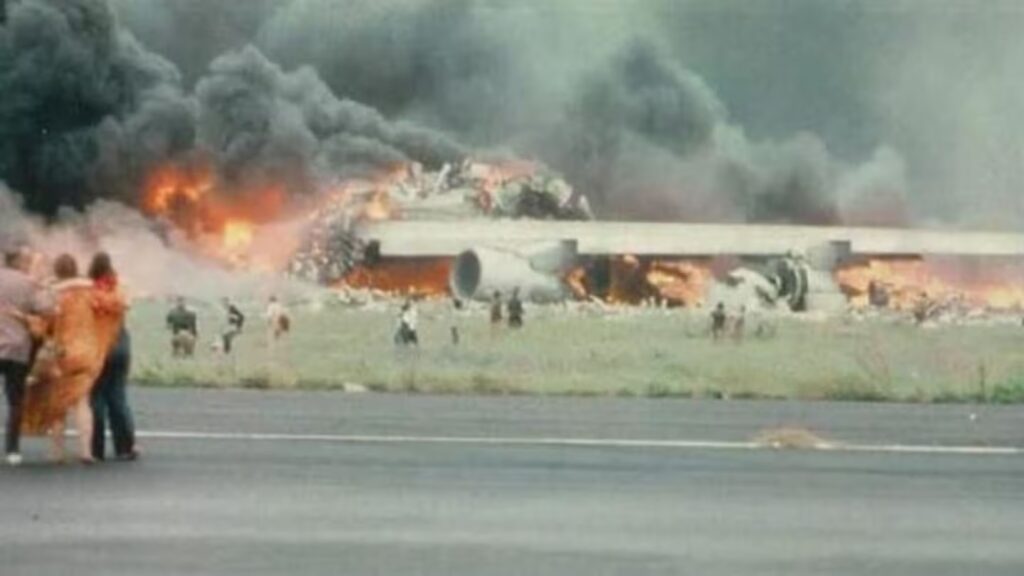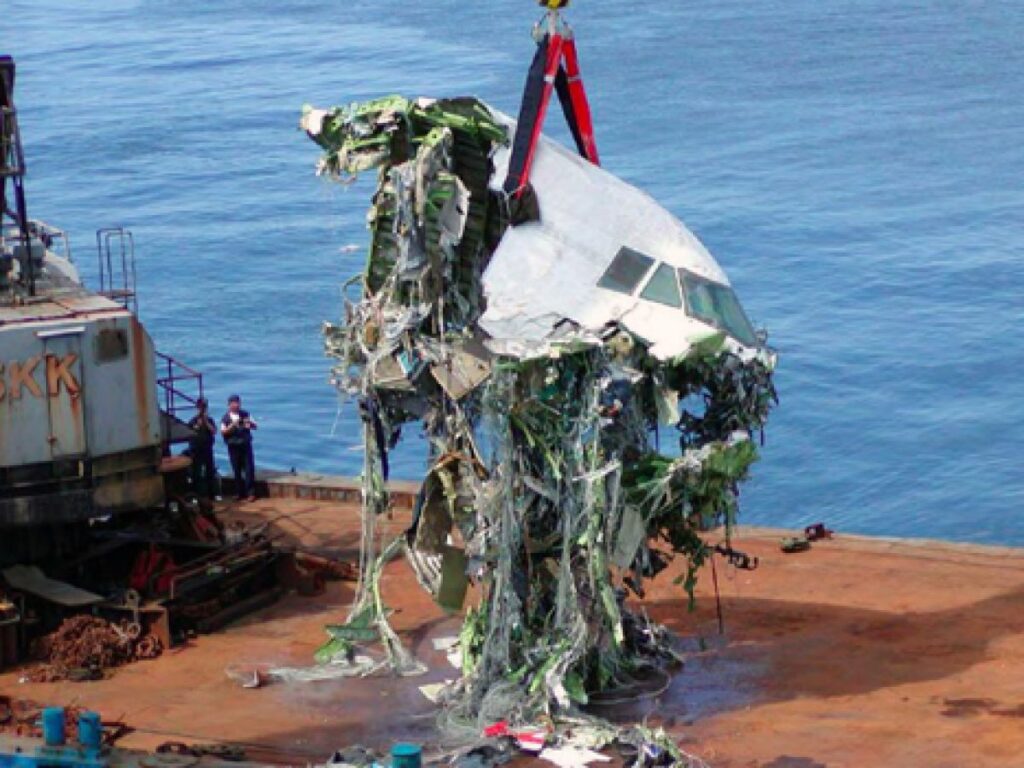For many of us, it’s our worst nightmare: a malfunction on an airplane while flying 35,000 feet in the air.
Even minor turbulence can cause passengers to panic about their safety, though it’s important to note that it’s rare for things to go so catastrophically wrong while traveling by plane.
Still, improbable doesn’t mean impossible.
Despite air travel being deemed safer than just about every other mode of transportation, things can—and do—go tragically wrong.
In some cases, hundreds of people’s lives have ended in one awful event, which was undeniably terrifying for those who endured it.
Here are just some of the worst air disasters in aviation history.
1979 American Airlines Flight 191: 271 Lives Lost
On May 25, 1979, American Airlines Flight 191 was headed to LAX from Chicago O’Hare International Airport.


However, just over 30 seconds after ascending, the plane essentially fell apart mid-air. The left engine separated from the wing, damaging the hydraulic systems and completely separating the control systems.
In other words, the plane was rendered uncontrollable, even by the two experienced pilots at the helm.
No doubt, the pilots knew what was coming, though they had tried in vain to stabilize the aircraft, perhaps not fully aware of just how dire their situation was.
The plane had only managed to get just over 300 feet in the air before it came hurtling back down to land at speed, taking all 271 people aboard with it. It crashed into a field and burst into unstoppable flames.
The 258 passengers and 13 crew members wouldn’t survive. Then, there were a further two casualties on the ground, with two airport workers succumbing to the crash.
A nearby trailer park also suffered some damage, with debris and fire raining down on the area.
A total of 273 people perished that day, resulting in the deadliest aviation accident in U.S. history.
Eventually, an investigation was ordered to understand why the accident happened.
Sadly, it was found that the plane’s malfunction had been preventable, and human error had caused the engine to break away from the plane.
Improper maintenance procedures saw the plane’s mechanics use forklift trucks to remove and reinstall the engine.
This put a huge strain on the pylon that should have connected the engine to the wing, and over time, the engine slowly broke away.
Although the tragedy was undeniably catastrophic, the aftermath saw changes made to the way the McDonnell Douglas DC-10 jet was maintained.
Inspections were increased across all airlines, and safety finally became of critical importance to airlines.
1985 Japan Airlines Flight 123: 520 Lives Lost
Where American Airlines Flight 191 was the biggest aviation disaster in U.S. history, Japan Airlines Flight 123 is the deadliest single-aircraft crash in aviation history.

The death toll hit a terrifying 520 people, though, unlike the American Airlines disaster, four people miraculously made it out alive.
The Boeing 747SR took off from Tokyo’s Haneda Airport on August 12, 1985, heading to Osaka. Initially, everything was fine: the takeoff was smooth, and there were no problems during the first few minutes of the flight.
However, the pilot quickly realized something had happened when he was abruptly losing altitude. By this point, the plane had fallen 3000 meters rapidly, no doubt scaring the passengers aboard.
He sent a distress call, and somehow, he was able to keep the aircraft in the air despite the fact that the rear pressure bulkhead had ruptured.
This resulted in explosive decompression, rendering the plane just about uncontrollable.
Around 45 minutes after takeoff, the plane crashed into Mount Takamagahara, where the conditions were dire.
So much so that it took rescue teams 14 hours to get there after the crash, with paratroopers descending from helicopters to scour the debris, by some miracle, among the wreckage, they found four survivors.
There was evidence that some more passengers had survived the initial crash but eventually succumbed to their injuries and the harsh environment before help could get to them.
The malfunction was blamed on unsuitable repairs being carried out on the aircraft.
A look back at the plane’s repair history shows that the bulkhead was fixed using a single row of rivets—less than half of the components required to fix it securely.
Over the years, this became weaker and weaker. Eventually, it gave way, triggering the crash that would see 520 people lose their lives.
The 1977 Tenerife Airport Disaster
The Japan Airlines Flight 123 incident is sadly the greatest loss of life for a singular aircraft disaster. The Tenerife Airport disaster of 1977 is the deadliest plane crash in history, taking 583 lives and injuring 61 more.

In March of that year, two jumbo jets–KLM Flight 4805 and Pan Am Flight 1736 collided with one another.
Each aircraft had been diverted from its original airport due to a threat at Gran Canaria Airport.
That meant Los Rodeos Airport, now known as Tenerife North Airport, was much busier than usual. The taxiways were crowded, with more planes than the airport could comfortably accommodate.
Add to the fact that the weather was foggy and murky that day, and you have a recipe for collision. Visibility was allegedly at 500 feet, which is far less than would be allowed nowadays.
KLM Flight 4805 began to take off without proper clearance while Pan Am Flight 1736 was making its way down the runway, trying to find the exit turnoff.
Air traffic control and the pilots of each aircraft suffered from miscommunication with one another, and nobody was aware the two planes were headed for collision.
The KLM Flight was hurtling down the runway and struck the Pan Am aircraft at high speed, causing an almighty ignition: every one of the KLM’s 248 passengers passed away in the explosion.
The Pan Am flight saw 335 people lose their lives. By a stroke of luck in the midst of tragedy, 61 of the Pan Am passengers were able to escape the flame-engulfed plane before it detonated entirely.
The awful event took place in 1977 when rules and regulations regarding air travel were lax.
The incident triggered monumental changes in aviation safety, including the introduction of standardized phraseology for use between pilots and air traffic control.
The procedure for takeoff clearance was also overhauled, making flying much safer than it had been previously.
1988 Iran Air Flight 655: 290 Lives Lost
Miscommunication played a big part in the Tenerife Airport disaster. The 1988 Iran Air incident was also due to improper communication, though the destruction of the aircraft was very much intended in this case.

On July 3 of that year, Iran Air Flight 655 was shot down by the U.S. Navy via a guided missile cruiser called the USS Vincennes. All 290 aboard the commercial aircraft perished as a result.
The flight was due to fly from Iran to Dubai, and after takeoff, it ascended into Iranian airspace as it made its way over the Persian Gulf.
At the time, tensions were high due to the Iran-Iraq War, and the U.S. Navy’s guided missile cruiser mistook the plane for a military aircraft.
The crew aboard the USS Vincennes believed that Iran Air Flight 655 was, in fact, an Iranian fighter jet. These jets were deadly and could carry a range of missiles.
The crew members on Vincennes sent multiple warnings to the civilian aircraft, though these were unheeded; for whatever reason, the pilots didn’t respond. It could have been that they didn’t think the warning message was intended for them.
As a result, the Vincennes launched two missiles toward the plane, which caused it to collapse 35,000 feet in the air. All 290 on the plane perished. Sixty-six of those victims were children.
In the aftermath, many labeled Vincennes’s actions reckless. After all, Iran Air was transmitting a civilian signal and was within the established air route it should have been.
This didn’t match the U.S. officials’ initial version of events: they said that the plane had been hurtling toward Vincennes at high speed, causing them to believe it was a genuine threat.
Later, U.S. officials labeled it an awful mistake, and in 1996, they paid $61.8 million in compensation to the victims’ families. It’s been noted that no formal apology has ever been given.
2002 China Airlines Flight 611: 225 Lives Lost
An airplane breaking apart mid-air is likely many people’s version of a nightmare; imagine sitting in your seat as the plane you’re traveling in simply falls apart around you. You’re helpless to do anything but accept your fate.

That’s just what happened to the passengers of China Airlines Flight 611, claiming the lives of all aboard the doomed Boeing 747-200.
The nightmarish event took place on May 25, 2002, as Flight 611 was cruising over the Taiwan Strait.
The flight was due to take travelers from Taiwan to Hong Kong, setting off from Chiang Kai-shek International Airport just after 7 am.
Upon reaching 35,000 feet, the plane began to break apart, piece by piece.
As the plane disintegrated around them, neither the passengers nor the pilots—both of whom were highly experienced—could do anything to save themselves.
Debris fell from the sky and into the Strait beneath them. Survival was impossible.
After the awful incident, an investigation was conducted to ascertain what had happened. After all, no plane should simply disintegrate mid-flight.
It turned out the rupturing of the plane began over two decades earlier, in 1980.
That year, the plane’s tail struck the floor on landing, otherwise known as a tail strike, requiring repair. The temporary patch repair wasn’t enough to address the real issues with the plane, and eventually, China Airlines carried out permanent repairs.
However, these repairs were not carried out to Boeing’s strict specifications. This meant that the 747-200’s long-term structural integrity was compromised from that point onward.
It’s surprising that the aircraft was able to fly for over two decades before succumbing to its structural failure.
Sadly, it was Flight 611 that would see the weakened plane finally break. The fuselage simply couldn’t take any more pressure and broke apart.
Two hundred twenty-five people perished as a result, with only 175 ever being recovered. The victims all had head trauma, broken bones and fractures, back abrasions, and bleeding from their nose and mouth.
After the preventable disaster, China Airlines reformed its maintenance practices.
Despite the scary nature of aviation disasters, it’s important to remember the statistics: the odds of dying in a commercial plane crash are 1 in over 29 million.
Sources
https://www.britannica.com/event/American-Airlines-Flight-191
https://www.britannica.com/event/Mount-Osutaka-airline-disaster
http://news.bbc.co.uk/onthisday/hi/dates/stories/march/27/newsid_2531000/2531063.stm













Leave a comment